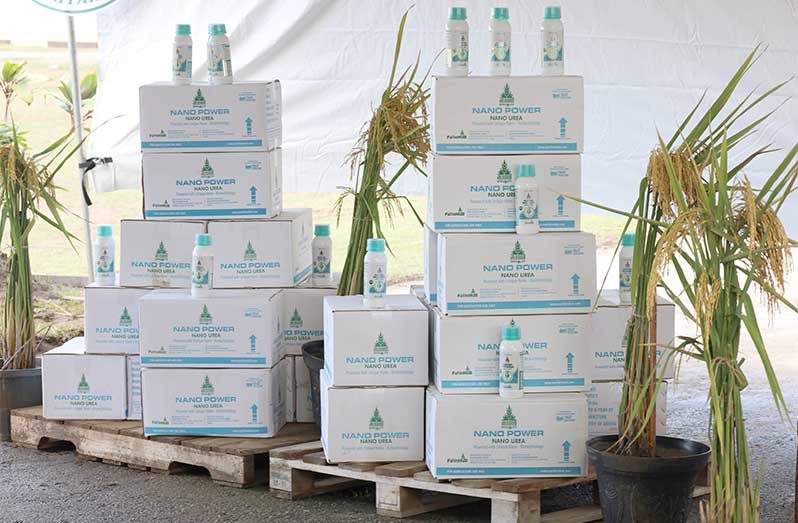– expected to cut costs and advance sustainable farming
IN a groundbreaking step toward transforming Guyana’s agricultural landscape, Minister of Agriculture, Zulfikar Mustapha, on Wednesday officially launched the country’s first-ever nano-technology fertiliser at the Burma Rice Research Station in Mahaicony.
The introduction of the fertiliser—developed through collaboration between the Guyana Rice Development Board (GRDB) and The Energy and Resources Institute (TERI) of India—marks a major milestone in the government’s push to modernise the sector, enhance productivity, and reduce environmental impacts.
Speaking at the event, Minister Mustapha described the launch as the beginning of a new era for rice cultivation and agricultural innovation in Guyana.
“The GRDB, in partnership with the Government of Guyana and our hardworking rice farmers, is leading a revolution in rice production,” the Minister stated. “Investments, increased farmer engagement, and timely interventions have resulted in higher yields—from 5.4 tonnes per hectare in 2021 to 6.6 tonnes per hectare in 2024. Production rose from 559,789 tonnes in 2021 to 725,282 tonnes in 2024, and we are on track to reach 824,000 tonnes in 2025. By 2030, Guyana is projected to produce more than one million tonnes of rice.”
The Minister noted that the adoption of nano fertilisers will help further boost yields while lowering costs and minimising nitrogen runoff.
“This fertiliser represents a key step in our agricultural transformation under the vision of President Dr. Mohamed Irfaan Ali,” Minister Mustapha explained. “It aligns with the CARICOM 25 by ’25 +5 Initiative, aimed at reducing the region’s food import bill by 25 per cent by 2025.”
Nano fertilisers, which deliver nutrients in microscopic particles, are designed to improve nutrient absorption and reduce wastage. The product launched in Guyana—Nano Urea—contains only eight per cent nitrogen, placing a far lower nitrogen load on the soil while supplying approximately 80 per cent of the nutrients crops require. When sprayed directly on plant leaves, it enables faster absorption, greater efficiency, and improved yields compared to conventional fertilisers.
According to Dr. G.R.N. Rao, Director of TERI, the technology will help revolutionise sustainable farming in Guyana and across the region.
“Nano Urea offers a competitive edge in every aspect of fertiliser application,” Dr. Rao said. “By integrating nano fertilisers with traditional farming practices, TERI projects up to a 50 per cent reduction in the use of chemical fertilisers in the medium term. This ensures precise nutrient delivery, reduced environmental impact, and improved crop yields.”
He added that Nano Urea is not limited to rice but can also be used for vegetables, sugarcane, soybeans, fruits, and other major crops, making it a versatile tool for diverse farming systems.
The introduction of nano fertilisers in Guyana began in mid-2022, following collaborative trials between GRDB and TERI. The partnership was strengthened after Vice President Dr. Bharrat Jagdeo’s visit to India in 2023, when the Government of Guyana and TERI signed a Memorandum of Understanding (MoU) to advance sustainable agricultural practices.
Since then, four successful crop-season demonstrations of Nano Urea have been completed at the Burma Rice Research Station. TERI has since signaled its readiness to establish a local production facility in Guyana—positioning the country as a regional hub for nano fertiliser manufacturing and distribution.
Minister Mustapha emphasised that the government remains focused on ensuring that Guyana’s agriculture sector remains competitive, resilient, and environmentally responsible.
“Every initiative—from developing new rice varieties to digitising rice lands and improving crop insurance—has strengthened the foundation of a modern, climate-smart rice industry,” he said.
The launch of Nano Urea reinforces Guyana’s commitment to innovation, sustainability, and regional food security, setting a new benchmark for agricultural transformation across the Caribbean.




.jpg)










